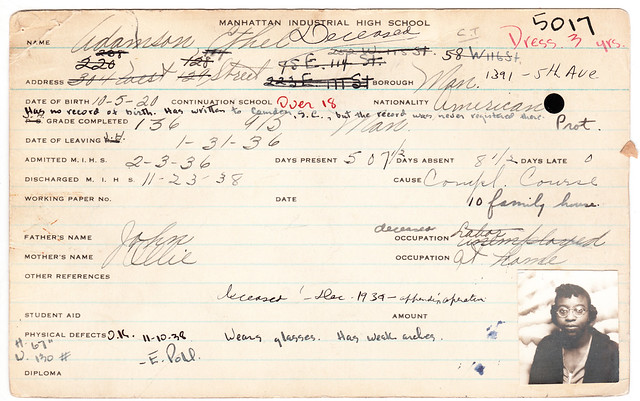
You may have noticed that Anna Green, who I wrote about a few days ago (she's the one who ended up drawing the short straw in a bankruptcy settlement), had a black dot on her report card -- a dot very much like the one that appears on Ethel Adamson's card, which is shown above. You may also have noticed that Anna and Ethel were both black.
This is no coincidence. Only about 5% of the Manhattan Trade School report cards in my collection are from black students, but they all have this small, adhesive black dot. The dot also appears on the card of a Native American student, and a Hispanic student was given half a dot. So the dots were apparently used for all students of color.
You've heard of the term "a black mark on your record"? Here it is, literally.
I initially thought the black dots were meant to stigmatize the students in some way (like a scarlet letter, or a concentration camp tattoo), but I eventually figured out a more benign reason for them. I don't want to give everything away, so I'll explain this more fully in the Slate series; for now, take my word when I say I don't think the dots are as offensive as they initially appear to be.

Keep up on the good work on this blog, Paul. It is proving most fascinating, and as always, your writing is top notch.
ReplyDeleteI am compelled to say one thing, though. I wish that researchers such as yourself who are investigating matters that might prove race-related would go into the process with a clean palate. Instead, however, it appears that you choose to assume the worst (intentional stigmatization . . . come on, this is a school is trying to help girls, not assign social strata) and determine whether it can disproven, rather than to simply try to solve the mystery.
Your examination of the Confederate battle flag on the Confederate Yankees had a similar feel to it.
Wouldn't it be better to think, "Wow, look at that; I wonder what was behind it" instead of "Here is another example of racism in America; let's expose it further"?
Regardless, I truly enjoy your work. Thank you for it.
Robert Eden
come on, this is a school is trying to help girls, not assign social strata
ReplyDeleteActually, Robert, the report cards include quite a few instances of the school making value judgments on social strata.
Since I've had the report cards in my possession for nearly 15 years, and you've read this blog for a few days, maybe -- just maybe -- I'm in a better position to assess the information on the report cards than you are.
Paul, this keeps on getting more interesting and I'm really anxious to read the Slate articles. Well done.
ReplyDeleteI wish that researchers such as yourself who are investigating matters that might prove race-related would go into the process with a clean palate. Instead, however, it appears that you choose to assume the worst (intentional stigmatization . . . come on, this is a school is trying to help girls, not assign social strata) and determine whether it can disproven, rather than to simply try to solve the mystery.
Robert, your approach sounds great ... if history occurred in a vacuum void of any context. Reading racism into a confederate flag on a baseball team's uniform in the midst of the Civil Rights movement isn't assuming the worst--it's interpreting an image within the historical context it took place. Any responsible historian or researcher wouldn't rest on that interpretation, though, and should seek out additional (preferably verbal or textual) sources and evidence. Which is exactly what Paul did in the Confederate Yankees article, and that resulted in a more nuanced understanding of the whole affair. Based on what he's presented here, I have no reason to doubt he's been equally thorough and sensitive in his study of these report cards and the ways they reflect class and race in the early 20th century.